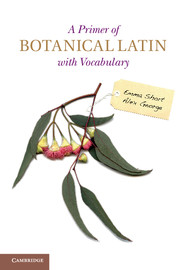Book contents
- Frontmatter
- Contents
- Preface
- Acknowledgements
- Introduction
- Part I Grammar
- 1 The noun
- 2 The adjective and the participle
- 3 The adverb
- 4 The preposition
- 5 The conjunction
- 6 The pronoun
- 7 The verb
- 8 Numerals, measurements (Stearn pp. 107–117)
- 9 Prefixes and suffixes
- 10 Miscellany
- Part II Exercises in translation
- Part III Translating
- Part IV Vocabulary
- References and further reading
- Index
7 - The verb
Published online by Cambridge University Press: 05 April 2013
- Frontmatter
- Contents
- Preface
- Acknowledgements
- Introduction
- Part I Grammar
- 1 The noun
- 2 The adjective and the participle
- 3 The adverb
- 4 The preposition
- 5 The conjunction
- 6 The pronoun
- 7 The verb
- 8 Numerals, measurements (Stearn pp. 107–117)
- 9 Prefixes and suffixes
- 10 Miscellany
- Part II Exercises in translation
- Part III Translating
- Part IV Vocabulary
- References and further reading
- Index
Summary
‘Botanists manage verbs best by avoiding them altogether’
(Stearn p. 130)A verb is a ‘doing’ word, i.e. it denotes an action. The most important aspects of verbs are person (I, you, he, she, it, we, they), number (singular, plural), voice (active, passive), tense (present, past, future, etc.), and mood (indicative, subjunctive, imperative). In Latin, each of these attributes is indicated by a single form of the verb, e.g. lego (I collect), legunt (they collect), legitur (it is collected), legistis (you have collected), lege! (collect!), lexerim (I might have collected). The basic part of a verb is called the stem, and the letters after it tell you the rest.
If you must know, the verb finite (i.e. limited by person and number) has three persons, two numbers, six tenses and three moods, while the verb infinite (not so limited) has infinitives, three participles, the gerund and gerundive and two supines. And there are two voices. And, on top of that, there are conjugations, four of them, plus – you guessed it – irregular, defective and what are called impersonal verbs. Fortunately, there is no need to learn these in detail, since those verbs used nowadays in botany are mostly third person singular, as set out below.
- Type
- Chapter
- Information
- A Primer of Botanical Latin with Vocabulary , pp. 47 - 49Publisher: Cambridge University PressPrint publication year: 2013



